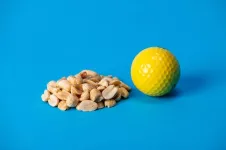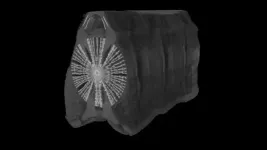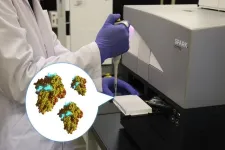(Press-News.org) AMES, Iowa — Approximately one in three deaths in the U.S. is caused by cardiovascular disease, according to the U.S. Centers for Disease Control and Prevention. A robust body of evidence shows aerobic exercise can reduce risks, especially for people who are overweight or obese. But few studies have compared results with resistance exercise — also known as strength or weight training — or with workout regimens that are half aerobic and half resistance. Researchers at Iowa State University led one of the longest and largest supervised exercise trials to help fill this gap.
Their results, published in European Heart Journal, indicate that splitting the recommended amount of physical activity between aerobic and resistance exercise reduces cardiovascular disease risks as much as aerobic-only regimens. Resistance exercise on its own for the same amount of time did not provide the same heart health benefits when compared to the control group.
“If you’re bored with aerobic exercise and want variety or you have joint pain that makes running long distances difficult, our study shows you can replace half of your aerobic workout with strength training to get the same cardiovascular benefits. The combined workout also offers some other unique health benefits, like improving your muscles,” says Duck-chul Lee, lead author and professor of kinesiology at Iowa State.
Performing a certain number of sets and repetitions with weight machines, free weights, elastic bands or your own body weight through push-ups or lunges, all fall under resistance exercise.
“One of the most common reasons why people don’t exercise is because they have limited time. The combined exercise with both cardio and strength training we’re suggesting is not more time consuming,” Lee underscores.
Co-authors from Iowa State include Angelique Brellenthin, associate professor of kinesiology; Lorraine Lanningham-Foster, department chair and associate professor of food science and human and nutrition; Marian Kohut, the Barbara E. Forker Professor in kinesiology. Yehua Li, professor of statistics at the University of California Riverside, also contributed.
In the paper, they wrote: “These findings may help develop clinical and public health practices and recommendations for the approximately 2 billion adults with overweight or obesity worldwide who are at increased risk of [cardiovascular disease.]”
One of the longest, largest exercise trials
Four hundred and six participants between 35 and 70 years of age enrolled in the one-year randomized controlled exercise trial. All met the threshold for being overweight or obese with body mass indexes between 25-40 kg/m2 and had elevated blood pressure.
The researchers randomly assigned participants to one of four groups: no exercise, aerobic only, resistance only, or aerobic plus resistance. Those who were in one of the three exercise groups worked out under supervision for one hour, three times a week for one year.
Every participant in one of the exercise groups received a tailored workout routine based on their individual fitness levels, health conditions and progression. Those assigned to resistance training were given a certain number of sets, repetitions and weights for weight-lifting machines. With aerobic exercises, participants wore a heart rate monitor and inserted a unique exercise program key into a treadmill or stationary bike. Sensing the participant’s heart rate, the machine automatically adjusted the speed and grade to match the prescribed intensity.
Researchers collected physical activity and diet data outside the lab, as well. All participants, including those in the no exercise group, wore pedometers to measure daily steps. They met every three months with registered dietitians at Iowa State for “Dietary Approaches to Stop Hypertension” education, which is promoted by the National Institutes of Health. On three random days per month, participants were asked to record what they had consumed in the last 24 hours with an online dietary assessment tool developed by the U.S. National Cancer Institute.
At the start of the year-long clinical trial, six months in and at the end, the researchers measured each participant’s systolic blood pressure, low-density lipoprotein cholesterol, fasting glucose and body fat percentage. All are well-established cardiovascular disease risk factors.
“Many previous studies only looked at one of these four factors, but it’s really multiple factors combined that increase cardiovascular disease risk,” explains Lee.
The researchers used a composite score to fairly quantify changes across all four factors since each uses a different unit of measurement. A lower composite score indicates less risk for developing cardiovascular disease.
Main findings
At the end of the year-long trial, the percentage of body fat in all three exercise groups had decreased significantly compared to the no-exercise control group. The authors write in the paper that “every -1% body fat reduction is associated with -3%, -4%, and -8% lower risks of developing [cardiovascular disease] risk factors of hypertension, hypercholesterolemia, and metabolic syndrome.”
However, taking all four cardiovascular disease risk factors into account, the aerobic and combined exercise groups had lower composite scores than the control group. The results were consistent across gender and age.
Secondary findings
Over the course of the 12-month study, those in the aerobic-only group continued to improve with the VO2max test, which is the maximum rate of oxygen consumption attainable during a maximal treadmill test. The resistance-only group stayed relatively flat. The inverse was true for the maximal bench and leg press tests for muscular strength; the resistance-only group continued to improve while the aerobic-only group did not.
However, the combination exercise group improved both aerobic fitness and muscular strength.
Finding the right dose
The authors say their findings support “physical activity guidelines recommending both resistance and aerobic exercise by the U.S., [World Health Organization] and European Society of Cardiology, specifically for individuals with obesity.” Currently, it’s at least 150 minutes each week of moderate intensity aerobic exercise and two sessions per week of resistance training.
“But these guidelines don’t specify how long those strength training sessions should be to get the health benefits,” says Lee.
With a newly awarded grant from the National Heart, Lung and Blood Institute, Lee wants to find “the right dose” of resistance exercise among adults who are overweight or obese. He plans to conduct another randomized controlled resistance exercise trial, this time with 240 participants. The study will compare results from 0-, 15-, 30- and 60-minute resistance sessions, twice per week for six months in a supervised exercise lab. Participants in all four groups also will be asked to do 30-minute sessions of moderate intensity aerobic exercise, twice per week, per the physical activity guidelines.
During the second six-month phase, participants will receive a free health club membership and be asked to continue their assigned regimen, unsupervised. Lee explains this will help identify which dose of resistance exercise is both effective and feasible outside experimental trials.
END
New research finds half-cardio, half-strength training reduces cardiovascular disease risks
2024-01-17
ELSE PRESS RELEASES FROM THIS DATE:
ECOG-ACRIN Cancer Research Group melanoma research team led by Michael Atkins, MD, receives the 2023 Paper of the Year distinction from the Journal of Clinical Oncology
2024-01-17
A team of melanoma researchers with the ECOG-ACRIN Cancer Research Group (ECOG-ACRIN) is honored with the 2023 Paper of the Year distinction by the Journal of Clinical Oncology. The recognition is for the results of the DREAMseq randomized phase 3 clinical trial. DREAMseq (EA6134) showed an optimal treatment sequence for combination therapy in patients with advanced melanoma with a BRAFV600 tumor gene mutation. The treatment sequence beginning with immunotherapy (nivolumab and ipilimumab), followed by targeted therapy (dabrafenib and trametinib) if there was disease progression, resulted ...
The American Journal of Clinical Nutrition launches new article series to educate physicians and other health care professionals on nutrition
2024-01-17
Rockville, MD (January 16, 2024) – To educate physicians and other health care professionals on the fundamentals of nutrition, The American Journal of Clinical Nutrition has launched a new article series titled Nutrition for the Clinician. The effort supports the White House National Strategy on Hunger, Nutrition, and Health and its directives to expand nutrition knowledge of health care providers, an effort long supported by the American Society for Nutrition. Nancy Krebs, MD, MS, Professor of Pediatrics, University of Colorado ...
New research shows that most early galaxies looked like breadsticks rather than pizza pies or dough balls
2024-01-17
Columbia researchers analyzing images from NASA’s James Webb Space Telescope have found that galaxies in the early universe are often flat and elongated, like breadsticks—and are rarely round, like balls of pizza dough. “Roughly 50 to 80% of the galaxies we studied appear to be flattened in two dimensions,” explained Viraj Pandya, a NASA Hubble Fellow at Columbia University, and the lead author of a new paper slated to appear in The Astrophysical Journal that outlines the findings. “Galaxies that look like long, thin breadsticks seem to be very common in the early universe, which is surprising, since they are uncommon among galaxies ...
Podcasts and compulsory attendance improved student learning
2024-01-17
Consider a group of new sociology students who are about to dive into a completely new subject. Half of them are fresh out of upper secondary school.
They need to settle into student life and get to know other students. They are about to embark on studies in a new field and must learn new ways of acquiring knowledge, regardless of their discipline.
They also need to come to grips with concepts such as legitimation, linguistic objectification, internalization and externalization. What on Earth do ...
Brush biopsy enables early detection of oral cancer without surgery
2024-01-17
A new test invented by University of Illinois Chicago researchers allows dentists to screen for the most common form of oral cancer with a simple and familiar tool: the brush.
The diagnostic kit, created and patented by Guy Adami and Dr. Joel Schwartz of the UIC College of Dentistry, uses a small brush to collect cells from potentially cancerous lesions inside the mouth. The sample is then analyzed for genetic signals of oral squamous cell carcinoma, the ninth most prevalent cancer globally.
This new screening method, which is currently seeking commercialization ...
Diets rich in plant protein may help women stay healthy as they age
2024-01-17
Women who consume higher amounts of protein, especially protein from plant-based sources, develop fewer chronic diseases and are more likely to be healthier overall as they age, according to a study led by researchers at the Jean Mayer USDA Human Nutrition Research Center on Aging (HNRCA) at Tufts University and published Jan. 17 in The American Journal of Clinical Nutrition.
Analyzing self-reported data from more than 48,000 women, the researchers saw notably less heart disease, cancer, and diabetes, and cognitive and mental health decline, in those who included more protein in their diets from sources such as fruits, ...
Study uncovers mechanics of machete-like ‘tail-whipping’ in thresher sharks
2024-01-17
Like Indiana Jones, thresher sharks (Alopias spp.) have mastered the art of the whip using their tails. With incredible speed, their long, machete-like tails can slap and stun their prey, allowing them to swallow multiple fish in one fell swoop. Their exceptionally elongated tail, which can often be as long as their entire body, not only makes this particular shark unique, but also a formidable hunter.
Thresher shark “tail-whipping” consists of four phases: preparation, strike, wind-down recovery, and prey collection. Overhead tail slaps begin in the preparation phase by lunging ...
Glowing COVID-19 diagnostic test prototype produces results in one minute
2024-01-17
Cold, flu and COVID-19 season brings that now-familiar ritual: swab, wait, look at the result. But what if, instead of taking 15 minutes or more, a test could quickly determine whether you have COVID-19 with a glowing chemical? Now, in ACS Central Science, researchers describe a potential COVID-19 test inspired by bioluminescence. Using a molecule found in crustaceans, they have developed a rapid approach that detects SARS-CoV-2 protein comparably to one used in vaccine research.
From fireflies ...
Microplastics from natural fertilizers are blowing in the wind more often than once thought
2024-01-17
Though natural fertilizers made from treated sewage sludge are used to reintroduce nutrients onto agricultural fields, they bring along microplastic pollutants too. And according to a small-scale study published in ACS’ Environmental Science & Technology Letters, more plastic particles get picked up by the wind than once thought. Researchers have discovered that the microplastics are released from fields more easily than similarly sized dust particles, becoming airborne from even a slight breeze.
Microplastics, or small bits of plastic less than 5 millimeters long, have appeared everywhere from clouds to heart tissues. And with these plastics’ increasing prevalence in ...
New AI makes better permafrost maps
2024-01-17
LOS ALAMOS, N.M., Jan. 17, 2024 — New insights from artificial intelligence about permafrost coverage in the Arctic may soon give policy makers and land managers the high-resolution view they need to predict climate-change-driven threats to infrastructure such as oil pipelines, roads and national security facilities.
“The Arctic is warming four times faster than the rest of the globe, and permafrost is a component of the Arctic that’s changing really rapidly,” said Evan Thaler, a Chick Keller Postdoctoral Fellow at Los Alamos National Laboratory. Thaler is corresponding ...





